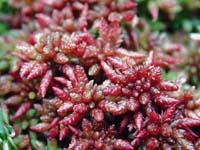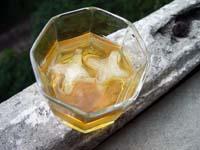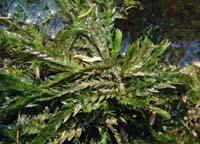Moss, plant relative despised

However, the use known to most is not real. It is said to be useful in guiding the observation of where moss grows. In fact, it has always been said that moss grows on the north side and serves to obtain a reference point in case of loss in the forest. But unfortunately that is not entirely true.
Moss grows mainly in wet and dark areas. In the northern hemisphere, the sun creates the shade generally to the north, resulting in an appropriate place for moss on the north side of stones and trees. In the southern hemisphere, for its part, the shadows originate mainly towards the south, where most of the moss is born. But in poorly lit forests, for example, any place can be appropriate and moss can be born anywhere. Therefore, if lost in the forest, it is more useful to have the compass at hand.
Excellent absorption capacity
Moss has not served to find the north, but it has served for the comfort of children and parents. Several wet and cold countries, such as the Inuit, used Sphagnum moss as an absorbent in children's diapers. Inuit made animal leather diapers and inside they were put moss, taking advantage of their absorption capacity.

Over the years, diaper technology has evolved, but they have taken into account the old idea. In fact, the company Johnson Johnson Inc. patented in 2003 a compound added to the cellulose of diapers or compresses used to absorb bodily exudations by Sphagnum moss fiber.
This has been the absorption capacity of liquids, which has most encouraged the use of moss. For example, in Britain it has been used for firefighting. The extraction of water from streams that do not have a significant flow, for example, to extinguish a fire, was quite difficult. However, in such areas, a kind of moss grows on the water and collects large amounts of water to survive. Therefore, in situations where water was necessary, this moss became a source of water that served to extinguish the fire. Hence the name Fontinalis antipyretica to this species of moss, known in many languages with names related to water.
River decontamination
Like Fontinalis antipyretica, the Sphagnum magellanicum also lives on the banks of the river. There it accumulates water in its fibers to cope with times of drought. Specifically, when filled with water, it can weigh 23 times its dry weight. This moss contains tonel-shaped cells to collect fluid. When the plant dries, these cells in the form of vats expand and become a collector of the liquid.
A group of Colombian scientists have announced that the absorption capacity of Sphagnum magellanicum can be used to combat hydrocarbon spills. Colombian rivers are very polluted by this type of dumping, to the detriment of animals and plants. Looking for the solution to this problem, plant fibers with absorption capacity such as moss and coconut fiber and cane were tested. In the study they discovered that the species Sphagnum magellanicum is the one that has the highest capacity of absorption of liquid.

In addition to hydrocarbons, moss is able to retain other elements. Therefore, it is also used to filter dirty water, such as acidic and toxic waters of industries, containing heavy metals or organic substances, oils and detergents, etc.
Useful when rotting
Peat is formed by plants in the first putrefaction phase. It can consist of several plants, according to which one or another kind of peat is obtained. An important class is peat made up of moss species from the Sphagnum family. This type of peat is widely used in horticulture. Due to its ability to maintain moss moisture, it is incorporated into the soil and improves the cultivation capacity.
In addition, Sphagnum moss peat, like other mobs, serves as fuel. Peat is an easy-to-use, efficient and low-cost fuel that can achieve the same quality as charcoal. It is rich in carbon and facilitates combustion. Therefore it is mainly used in domestic and industrial heating.

Moss has the highest economic and commercial value in peat state. Sphagnum moss peat has been commercially exploited for 150 years. In addition, in many countries the use of this type of fuel has increased due to the energy crisis.
But massive peat exploitation can cause problems. This commercial activity deteriorates and destroys the natural habitat, not only by the extraction of peat, but also by the degradation of the environment generated by the labor, instrumental and transport movement. This is the problem they have in South America. In fact, most of the peatlands in the southern hemisphere, Sphagnum, are located in the 400 square kilometers of Tierra del Fuego. Experts believe that some peatlands in this area are in danger of extinction and that if not used carefully this useful raw material will end.
Mosses in food
Much of moss fiber is dietary fiber, i.e. edible. For example, in countries like Finland or Chile, they have been used in times of famine to make moss bread. Moss, very abundant in these places, has been used as raw material when it only existed.
According to some current studies, moss can be a source for obtaining the fiber that humans need in food and is being researched for use in current bread production. But, although it can be eaten, very few groups or animals eat and are not the staple food of any of them. Why is not very clear. The debate is open, but no one has given any reason.

Medical uses
Scientists have found that certain mosses have antibiotic and antitumor properties through chemical analyses. Moss extracts contain phenolic compounds that have been shown to prevent the growth of fungi and bacteria. The concentrates of these extracts have observed antitumor capabilities in laboratory animals.
In addition, some mosses have a number of antiseptic properties that have helped heal wounds. In addition, moss has greater absorption capacity than cotton and is II. In the World War, when cotton was lacking to heal the wounds of the soldiers, moss was used. And the infusion of moss used in firefighting, such as Fontinalis antipyretica, serves to reduce fever. Moss can therefore also be a medicinal herb.
In addition, other physical characteristics have allowed humans to use moss in their daily lives. Because of its light fibers it has been used for the filling of mattresses and pillows, as well as for the collection of vegetables, fruits, flowers, etc., for use as protective cover during transport.

Moss can therefore have many and very different uses. All of these uses are little known, although for centuries moss has been used for many things. Throughout history it has facilitated the lives of many in the case of diapers. It also meets the needs of others when used to make bread. Or, if not more, has collaborated in the execution of aesthetic needs, when it has been used to decorate the nativity scenes or Christmas gardens.
In Christmas births, in diapers, to extinguish fires, to make bread, in cultivation, as fuel, in mattresses and pillows, to filter water, to replace cotton, medicinal herbs... Will you find any other use in the future?






